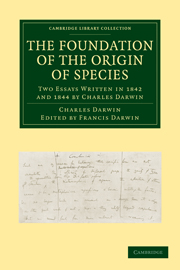Book contents
- Frontmatter
- Contents
- INTRODUCTION
- PART I
- PART II
- PART I
- PART II ON THE EVIDENCE FAVOURABLE AND OPPOSED TO THE VIEW THAT SPECIES ARE NATURALLY FORMED RACES, DESCENDED FROM COMMON STOCKS
- CHAPTER IV ON THE NUMBER OF INTERMEDIATE FORMS REQUIRED ON THE THEORY OF COMMON DESCENT; AND ON THEIR ABSENCE IN A FOSSIL STATE
- CHAPTER V GRADUAL APPEARANCE AND DISAPPEARANCE OF SPECIES
- CHAPTER VI ON THE GEOGRAPHICAL DISTRIBUTION OF ORGANIC BEINGS IN PAST AND PRESENT TIMES
- CHAPTER VII ON THE NATURE OF THE AFFINITIES AND CLASSIFICATION OF ORGANIC BEINGS
- CHAPTER VIII UNITY OF TYPE IN THE GREAT CLASSES; AND MORPHOLOGICAL STRUCTURES
- CHAPTER IX ABORTIVE OR RUDIMENTARY ORGANS
- CHAPTER X RECAPITULATION AND CONCLUSION
- INDEX
CHAPTER IX - ABORTIVE OR RUDIMENTARY ORGANS
Published online by Cambridge University Press: 07 September 2010
- Frontmatter
- Contents
- INTRODUCTION
- PART I
- PART II
- PART I
- PART II ON THE EVIDENCE FAVOURABLE AND OPPOSED TO THE VIEW THAT SPECIES ARE NATURALLY FORMED RACES, DESCENDED FROM COMMON STOCKS
- CHAPTER IV ON THE NUMBER OF INTERMEDIATE FORMS REQUIRED ON THE THEORY OF COMMON DESCENT; AND ON THEIR ABSENCE IN A FOSSIL STATE
- CHAPTER V GRADUAL APPEARANCE AND DISAPPEARANCE OF SPECIES
- CHAPTER VI ON THE GEOGRAPHICAL DISTRIBUTION OF ORGANIC BEINGS IN PAST AND PRESENT TIMES
- CHAPTER VII ON THE NATURE OF THE AFFINITIES AND CLASSIFICATION OF ORGANIC BEINGS
- CHAPTER VIII UNITY OF TYPE IN THE GREAT CLASSES; AND MORPHOLOGICAL STRUCTURES
- CHAPTER IX ABORTIVE OR RUDIMENTARY ORGANS
- CHAPTER X RECAPITULATION AND CONCLUSION
- INDEX
Summary
The abortive organs of naturalists.
Parts of structure are said to be “abortive,” or when in a still lower state of development “rudimentary,” when the same reasoning power, which convinces us that in some cases similar parts are beautifully adapted to certain ends, declares that in others they are absolutely useless. Thus the rhinoceros, the whale, etc., have, when young, small but properly formed teeth, which never protrude from the jaws; certain bones, and even the entire extremities are represented by mere little cylinders or points of bone, often soldered to other bones: many beetles have exceedingly minute but regularly formed wings lying under their wing-cases, which latter are united never to be opened: many plants have, instead of stamens, mere filaments or little knobs; petals are reduced to scales, and whole flowers to buds, which (as in the feather hyacinth) never expand. Similar instances are almost innumerable, and are justly considered wonderful: probably not one organic being exists in which some part does not bear the stamp of inutility; for what can be clearer, as far as our reasoning powers can reach, than that teeth are for eating, extremities for locomotion, wings for flight, stamens and the entire flower for reproduction; yet for these clear ends the parts in question are manifestly unfit.
- Type
- Chapter
- Information
- The Foundation of the Origin of SpeciesTwo Essays Written in 1842 and 1844 by Charles Darwin, pp. 231 - 238Publisher: Cambridge University PressPrint publication year: 2009First published in: 1909



